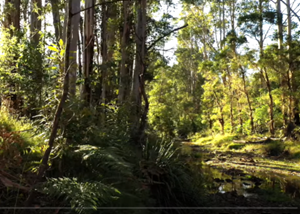This update represents just a handful among the hundreds of NRM projects happening across Australia, which are made possible through funding from the Australian Government and respective State governments.

First dedicated Aboriginal engagement team - Northern Tablelands Local Land Services, New South Wales
In a first for Local Land Services (LLS) in NSW, Northern Tablelands LLS have set up a dedicated four-person team for Indigenous engagement.
The Aboriginal Engagement Team have four new contracts on Aboriginal owned land throughout the New England region under the Saving Koala Fund project. The projects will involve fencing off waterways, installing water storage tanks, troughs and pumps; planting seedlings; installing koala feeders; and holding capacity building workshops.
Read more here.
Left to right: James Sheather (Aboriginal Cultural Broker), Jayden Potter (Land Services Officer), Ivan Lackay (Team Leader), Warren Kelly (Land Services Officer)

Weather Stations go 5G - Limestone Coast Landscape Board, South Australia
All twenty of the Limestone Coast Landscape Board’s Automatic Weather Stations (AWS) are now 5G- providing increased mobile device and connection capacity for landholders wanting to access their free local weather data. The AWS capture and store rainfall, temperature, humidity, global solar radiation and wind speed and direction in real time. They also calculate indicators like dew point, apparent temperature, growing degree days, chill hours, frost and evapotranspiration.
Limestone Coast Landscape Board Manager for Sustainable Landscapes Jason Taylor said "Timely decisions about when to sow and harvest and apply chemical sprays and fertilisers are critical to productivity success. Understanding the weather in real-time aligns the use of resources.”
Read more here.

Extending efforts to protect Swan galaxias – NRM South, Tasmania
A new grant delivered through the Australian Government’s ‘Saving Native Species’ program will enable NRM South to build on their work to translocate and establish two new populations of the endangered Swan galaxias.
Swan galaxias population decline is due to dispersal of invasive, predatory species, including trout and redfin perch; fragmentation and isolation from their preferred habitat; and susceptibility to changes in flow conditions, such as drought and flood.
Working with the Tasmanian Inland Fisheries Service and CSIRO, the new project will address these threats by building upon the translocation work in 2023, further establishing and securing insurance populations to ensure that genetic diversity is conserved in habitat that better protects Swan galaxias from the impacts of climate change.
Read more here.

New funding secured for turtle protection – Cape York, Queensland
Cape York NRM has secured funding from the Queensland government’s Department of Environment, Science & Innovation for the next two years to upskill the Western Cape Turtle Threat Abatement Alliance (WCTTAA) rangers in feral animal control.
The six Indigenous Land and Sea Ranger groups in the Alliance work from the Northern Peninsula area to Kowanyama, protecting endangered turtle species along eight beaches- about 220km of coastline.
The WCTTAA rangers will undertake firearms training ready for the 2025 aerial shoot, as well as additional training in feral animal control skills, like the use of foothold traps and aluminium welding for making turtle nest protection cages.
Read more here.

News getting better for the long-footed potoroo – North East Catchment Management Authority, Victoria
The Victorian Department of Energy, Environment and Climate Action (DEECA) Hume, and North East Catchment Management Authority are partnering on a range of projects around bushfire recovery, including monitoring species impacted by the fires. Remote camera monitoring is underway in the Barry Mountains for one of Victoria’s most threatened and elusive native species – the long-footed potoroo.
The recent results have revealed an increase in the population- 43% of the sites surveyed recorded potoroo presence, compared to 23% of sites after the 2019-20 Black Summer Bushfires.
In addition to the potoroos, the cameras captured 71 other native species, including long-nosed bandicoots, black wallabies, lyrebirds and even a red-bellied black snake.
Read more here.

Consolidating saltbush for carbon sequestration – Wheatbelt NRM, Western Australia
Wheatbelt NRM is collaborating with Murdoch University, Corrigin Farm Improvement Group (CFIG), Facey Group and the project funder, the Department of Primary Industries & Regional Development, to provide data around the ability of three species of saltbush to sequester carbon in saline agricultural land.
The project aims to inform a recognised methodology within the Australian Credit Unit Scheme (ACCU) for farmers to develop saltbush plantations on their salt-affected land to offset farm emissions or receive payment for carbon stored in the vegetation and soil.
Read more here.

Stockyard Creek rehabilitation success - Hunter Local Land Services, New South Wales
More than 20 years on, Hunter Local Land Services (LLS) have developed a video to share the learnings and success of the Stockyard Creek rehabilitation project. Starting as an experimental research project in 2002 when 23 engineered log jams (ELJs) were constructed along a 1km reach of Stockyard Creek at Paynes Crossing, the project highlights the ecosystem benefits of retaining large woody debris in waterways, extensive plantings, and ongoing weed control.
The Stockyard Creek section has suffered major fires and floods since the project began and a recent assessment by Hunter LLS have found that even though the log jams were damaged by these events, the work has still improved and maintained creek stability and plant diversity.
